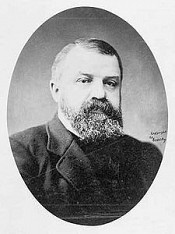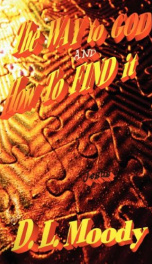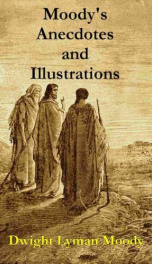Moody Dwight Lyman

Dwight Lyman Moody (February 5, 1837 - December 22, 1899), also known as D.L. Moody, was an American evangelist and publisher who founded the Moody Church, Northfield School and Mount Hermon School in Massachusetts (now the Northfield Mount Hermon School), the Moody Bible Institute and Moody Publishers. Dwight Moody was born in Northfield, Massachusetts to a large family. His father, a small farmer and stonemason, was an alcoholic and died at the age of 41 when Dwight was only four years old. He had five older brothers and a younger sister, with an additional twin brother and sister born one month after his father's death. His mother struggled to support the family, but even with her best effort, some of her children had to be sent off to work for their room and board. Dwight too was sent off, where he went he received cornmeal porridge and milk, three times a day. He complained to his mother, but when she found out that he had all that he wanted to eat, she sent him back. Even during this time, she continued to send them to church. Together with his eight siblings he was raised in the Unitarian church. His oldest brother ran away and was not heard from by the family until many years later. When Moody turned 17, he moved to Boston to work in his uncle's shoe store. One of his uncle's requirements was that Moody attend the Congregational Church of Mount Vernon where Dr. Edward Norris Kirk was pastor. In April 1855 Moody was then converted to evangelical Christianity when his teacher, Edward Kimball talked to him about how much God loved him. His conversion sparked the start of his career as an evangelist. However his first application for church membership, in May 1855, was rejected. He was not received as a church member until May 4, 1856. As his teacher, Mr. Edward Kimball, stated: Moody moved to Chicago, Illinois in September, 1856, where he joined the Plymouth Congregational Church, and began to take an active part in the prayer meetings. In the spring of 1857, he began to minister to the welfare of the sailors in Chicago's port, then gamblers and thieves in the saloons. A contemporary witness, William Ryenolds, recalled a few years later: [2] His work led to the largest Sunday School of his time. As a result of his tireless labor, within a year the average attendance at his school was 650, while 60 volunteers from various churches served as teachers. It became so well known that the just-elected President Lincoln visited and spoke at a Sunday School meeting on November 25, 1860. After the Civil War started, he was involved with the U.S. Christian Commission of the YMCA, and paid nine visits to the battle-front, being present among the Union soldiers after the conflicts of Shiloh, Pittsburgh Landing, and Murfreesboro, and ultimately entered Richmond with the army of General Grant. He married Miss Emma C. Revell, on August 28, 1862, with whom he had a daughter, Emma Reynolds Moody, and two sons, William Revell And Paul Dwight Moody. The growing Sunday School congregation needed a permanent home, so Moody started a church in Chicago, the Illinois Street Church. In June 1871, Moody met Ira D. Sankey, the Gospel singer, with whom he soon partnered. In October the Great Chicago Fire destroyed his church, his home, and the dwellings of most of his members. His family had to flee for their lives, and, as Mr. Moody said, he saved nothing but his reputation and his Bible. His church was rebuilt within three months at a near-by location as the Chicago Avenue Church. His lay follower William Eugene Blackstone was a prominent American Zionist. In the years after the fire, Moody's wealthy Chicago supporter J.A. Farwell attempted to persuade him to make his permanent home in Chicago, offering to build Moody and his family a new house. But the now-famous Moody, also sought by supporters in New York, Philadelphia and elsewhere, chose the tranquil farm he had purchased next door to his birthplace in Northfield, MA. He felt he could better recover from his lengthy and exhausting preaching trips in a rural setting. Northfield became an important location in evangelical Christian history in the late 19th century as Moody organized summer conferences which were led and attended by prominent Christian preachers and evangelists from around the world. It was also in Northfield where Moody founded three schools which later merged into today's Northfield Mount Hermon School. It was while on a trip to England in Spring of 1872 that he became well known as an evangelist. Some have claimed he was the greatest evangelist of the 19th century. He preached almost a hundred times and came into communion with the Plymouth Brethren. On several occasions he filled stadiums of 2,000 to 4,000 capacity. In the Botanic Gardens Palace, a meeting had between 15,000 to 30,000 people. This turnout continued throughout 1874 and 1875, with crowds of thousands at all of his meetings. During his visit to Scotland he was helped and encouraged by Andrew A. Bonar. The famous London Baptist preacher, Charles Spurgeon invited him to speak and promoted him as well. When he returned to the United States, crowds of 12,000 to 20,000 were just as common as in England. President Grant and some of his cabinet attended a meeting on January 19, 1876. His evangelistic meetings were held from Boston to New York, throughout New England and as far as San Francisco, and other West coast towns from Vancouver to San Diego. Moody aided in the work of cross-cultural evangelism by promoting "The Wordless Book", a teaching tool that had been invented by Charles Spurgeon in 1866. In 1875 he added a fourth color to the design of the three-color evangelistic device: gold - to "represent heaven". This "book" has been and is still used to teach uncounted thousands of illiterate people - young and old - around the globe about the Gospel message.[3] Dwight L. Moody visited Britain with Ira D. Sankey, with Moody acting as preacher and Sankey singing. Together they published books of Christian hymns. In 1883 they visited Edinburgh and raised £10,000 for the building of a new home for the Carrubbers Close Mission. Moody later preached at the laying of the foundation stone for what is one of the few buildings on the Royal Mile which continues to be used for its original purpose and is now called the Carrubbers Christian Centre. Moody greatly influenced the cause of cross-cultural Christian missions after he met the pioneer missionary to China, Hudson Taylor. He actively supported the China Inland Mission and encouraged many of his congregation to volunteer for service overseas. His influence was felt among Swedes despite the fact that he was of English heritage, never visited Sweden or any Scandinavian country, and never spoke a word of the Swedish language. Nevertheless, he became a hero revivalist among Swedish Mission Friends in Sweden and America.[4] News of Moody’s large revival campaigns in Great Britain from 1873–1875 traveled quickly to Sweden, making “Mr. Moody” a household name in homes of many Mission Friends. Moody’s sermons published in Sweden were distributed in books, newspapers, and colporteur tracts, and led to the spread of Sweden’s “Moody fever” from 1875–1880. He preached his last sermon on November 16, 1899 in Kansas City, KS. Becoming ill, he returned home by train to Northfield. During the preceding several months, friends had observed he had added some 30 pounds to his already ample frame. Although his illness was never diagnosed, it has been speculated that he suffered congestive heart failure. He died on December 22, surrounded by family. Already installed by Moody as leader of his Chicago Bible Institute, R. A. Torrey succeeded Moody as its president. Ten years after Moody's death, the Chicago Avenue Church was renamed The Moody Church in his honor, and the Chicago Bible Institute was likewise renamed Moody Bible Institute.
do you like this author?
What readers are saying
What do you think? Write your own comment on this book!
write a commentWhat readers are saying
What do you think? Write your own comment on this author!
write a commentBook list

Secret Poweror the Secret of Success in Christian Life and Work
Series:
Unknown
Year:
Unknown
Raiting:
3.5/5
Show more
add to favoritesadd In favorites
Book list

Secret Poweror the Secret of Success in Christian Life and Work
Series:
Unknown
Year:
Unknown
Raiting:
3.5/5
Show more
add to favoritesadd In favorites

Weighed and WantingAddresses on the Ten Commandments
Series:
Unknown
Year:
Unknown
Raiting:
3.5/5
Show more
add to favoritesadd In favorites

To The Work! To The Work!Exhortations to Christians
Series:
Unknown
Year:
Unknown
Raiting:
4.5/5
Show more
add to favoritesadd In favorites

Sovereign GraceIts Source,Its Nature and Its Effects
Series:
Unknown
Year:
Unknown
Raiting:
2.5/5
Show more
add to favoritesadd In favorites

Moody's Anecdotes And Illustrations
Related in his Revival Work by the Great Evangilist
Series:
Unknown
Year:
Unknown
Raiting:
3.5/5
Show more
add to favoritesadd In favorites

The Way to God and How to Find It
Series:
Unknown
Year:
Unknown
Raiting:
3.5/5
1884. Contents: Love that Passeth Knowledge; The Gateway into the Kingdom; The Two Classes; Words of Counsel; A Divine Savior; Repentance and Restitution; Assurance of Salvation; Christ All and in All; and Backsliding. See other titles by this author available from Kessinger Publishing. --This text refers to an alternate Paperback edition.
Show more
add to favoritesadd In favorites

That Gospel Sermon on the Blessed Hope
Series:
Unknown
Year:
Unknown
Raiting:
4/5
This book was converted from its physical edition to the digital format by a community of volunteers. You may find it for free on the web. Purchase of the Kindle edition includes wireless delivery.
Show more
add to favoritesadd In favorites

Moody's Anecdotes And Illustrations
Series:
Unknown
Year:
Unknown
Raiting:
4/5
PREFACE.The breathless interest given to Mr. Moody's anecdotes while being related by him before his immense audiences, and their wonderful power upon the human heart, suggested to the compiler this volume, and led him to believe and trust that, properly classified and arranged in book form, they would still carry to the general reader a measure of their original potency for good. The best anecdotes have been selected and carefully compiled under appropriate headings, alphabetically arranged, making the many stories easily available for the private reader and public teacher. Mr. Moody's idiom has been strictly preserved. He tells the story. "Gold" will be found scattered through the volume, which includes Mr. Moody's terse declarations of many precious and timely truths.The compiler acknowledges the benefit received from the extended reports of the Tabernacle meetings given in the Daily press of Chicago, also the Hippodrome services reported in the New York papers, and the volume of Addresses revised by Mr. Moody. With the earnest prayer that God's blessing may accompany the reading of these stories that have blessed so many thousands as they fell from the lips of the great Evangelist, this volume is dedicated to the public by the compiler, J. B. McClure Chicago, Ill.REVISED EDITION.We retain in this, all that was in former editions and give forty pages additional of new anecdotes, properly classified, taken from the revival work in Boston and elsewhere. We also give engravings of Messrs. Moody, Sankey, Whittle, and the late lamented P. P. Bliss, the four evangelists who have so long and industriously labored together, and whose names conjoined, are household words throughout the land. The hearty reception already given by the public to this book justifies these improvements, which are gladly made, and which lead the compiler to hope that in this form the volume may prove yet more interesting and effective for good.The engraving of Mr. Moody is from a copyrighted photograph by Gentile, used by permission. That of Mr. Whittle is by the same artist.J. B. Mc.
Show more
add to favoritesadd In favorites
What readers are saying
What do you think? Write your own comment on this author!
write a commentGenre
- Books
- Books / Different genres / Religion & Spirituality
- Books / Christian life
- Religion & Spirituality / Bible & Other Sacred Texts
- Books / Mary,Blessed Virgin, Saint
- Literature & Fiction / Authors, A-Z / (H)
- Arts & Photography / History & Criticism / Regional / African American
- Books / Great Britain / Politics and government / 19th century
- Books / Adams County (Ohio) / Biography
- Books / Blaine, James G. / (James Gillespie),1830-1893
if you like Moody Dwight Lyman try:
readers also enjoyed
What readers are saying
What do you think? Write your own comment on this author!
write a commentGenre
- Books
- Books / Different genres / Religion & Spirituality
- Books / Christian life
- Religion & Spirituality / Bible & Other Sacred Texts
- Books / Mary,Blessed Virgin, Saint
- Literature & Fiction / Authors, A-Z / (H)
- Arts & Photography / History & Criticism / Regional / African American
- Books / Great Britain / Politics and government / 19th century
- Books / Adams County (Ohio) / Biography
- Books / Blaine, James G. / (James Gillespie),1830-1893
if you like Moody Dwight Lyman try:
readers also enjoyed
Do you want to exchange books? It’s EASY!
Get registered and find other users who want to give their favourite books to good hands!

